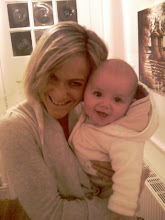Get ready to elevate your mood, energise and relieve anxiety and stress without pounding a gym or doing crunches.
Plus you can do them feeding the baby or online shopping or reading emails!
For all these exercises you want to imagine your lungs are in your stomach. Your stomach is like a balloon, inflating as you breathe in.
The ‘Belly Breath’
Most people don’t give much thought to how breathing can help them work their abdominal muscles! That’s because many people are ‘chest breathers’ - ‘anxiety’ led breathing in response to everyday life stressors. Correct breathing comes from the rib cage, taking air in and out from the part of the belly right below your ribs and feeling the inner most abdominal muscle move forwards and backwards.
Babies breathe deeply and correctly – just watch when they are sleeping their abdomen goes forward and backwards, which demonstrates my point!
Deep controlled breathing is also an exercise in relaxation, perfect for a new mum who feels overwhelmed or stressed out.
 What to do:
What to do:1.Sit in a chair with your back supported against the back of a chair or sit against a wall, lower back touching the wall.
2. Place your hands on your stomach above and below your belly button.
3. Breathe in through your nose and blow out your stomach – your stomach is filling with air so watch it expand!
4. Breath out through your mouth, empty your lungs and draw your belly button back in towards you and towards your spine.
5. You should feel your muscles going in and out, forward and backward.
When? When feeding baby, driving, sitting.
How many? 30 breaths drawing your belly button back x3 times a day.
Tip: If your chest rises up and down, this means you are not breathing from your diaphragm, rather breathing too quickly and with your chest. Keep focussed on breath from your stomach.
Relax your shoulders, pulling them down and back.
Stomach Flattener 1: Belly Stepping
 What to do:
What to do:- 1.Start seated and place one hand on your belly button and one hand above with fingers spaced.
- 2. Imagine your transverse (or corset) is a sideways muscle with six steps from belly button round to the parallel point of your spine (lower back). Move one hand around from belly button to the parallel point of your spine.
- 3. Take a ‘belly breath’ in, as above, feel the transverse muscle expand. Breathe out, pull your belly button in as if you are step backwards to the third step (half way between belly button point and spine). Hold your belly button here and continue to breathe in and out, counting out loud to ten.
- Now pull your belly button in more, imagine you going back two more steps to the 5th step. This point is ‘belly button to spine’. Count out loud to ten.
CHECK: Keep shoulders pulled down and back.
CHECK: Your chest has not risen. You should feel your ribs coming together.
Once you’ve mastered this, pull your belly button back one more step to the 6th step, as if it is pushing against a parallel point of your lower back.
How many? 30 repetitions x 3 a day.
Not the contractions you had during labour! These are more pleasant and get you to re-discover those deep stomach muscles.
What to do:
1. Start seated in a chair or against a wall, with lower back supported.
Place one hand above belly button, one hand below so you feel upper and lower abs, moving backwards.
2. Take a ‘belly breath’ in and your belly inflates.
3. Breath out and pull belly button back to the 3rd step. This is your start position. Now hold the belly button at that position and continue to breathe in and out.
4. Draw the belly button back further to 5th step (Ribs come together)
5. Then release just slightly go forward a little to 3rd step (avoid relaxing belly button completely – you need to keep holding). Count out loud for 3 counts.
6. Draw back to 5th step and hold. Count out loud for 3 counts.
How many? Repeat x 50 (starting at 3rd step, back to 5th step and back to third step is 1 repetition).
When? Whilst feeding the baby or online shopping. Babies love this too – they feel the motion of your transverse muscles as it’s the same side to side movement they felt when they were inside you and you were walking.
.jpg)


No comments:
Post a Comment